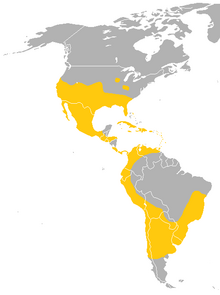Tadarida brasiliensis
| Mexican free-tailed bat Tadarida brasiliensis |
|
|---|---|
 |
|
| Scientific classification | |
| Kingdom: | Animalia |
| Phylum: | Chordata |
| Class: | Mammalia |
| Order: | Chiroptera |
| Family: | Molossidae |
| Genus: | Tadarida |
| Species: | T. brasiliensis |
| Binomial name | |
|
Tadarida brasiliensis (I. Geoffroy, 1824) |
|
| Subspecies | |
|
|
 |
|
| Range of the Mexican free-tailed bat | |
The Mexican free-tailed bat or Brazilian free-tailed bat (Tadarida brasiliensis) is a medium-sized bat that is native to the Americas, regarded as one of the most abundant mammals in North America. Its proclivity towards roosting in huge numbers at relatively few locations makes it vulnerable to habitat destruction in spite of its abundance. The bat is considered a species of special concern in California as a result of declining populations. It has been claimed to have the fastest horizontal speed of any animal, reaching top ground speeds of over 160 km/h; its actual air speed has not been measured.
Molecular sequence data indicates T. brasiliensis's closest relatives are Chaerephon jobimena of Madagascar and Tadarida aegyptiaca of Africa and south Asia; the latter two are sister species. These three species form a clade believed to be about 9.8 million years old.
Mexican free-tailed bats are on average 9 cm (3.5 in) in length and weigh approximately 12.3 g (0.43 oz). The average wingspan is 28 cm (11 in). Their tail is almost half their total length and stretches beyond the uropatagium, giving them the name "free-tailed" bats. Their ears are relatively close behind the muzzle and eyes; they are wide and set apart to help them find prey using echolocation. The muzzle is condensed, with wrinkled upper lips. The wings are elongated and narrow with pointed tips, making them well-equipped for quick, straight flight patterns. Their fur color ranges from dark brown to gray.
The Mexican free-tailed bat ranges from the southern half of the continental United States through most of Mexico, and through most of Central America into South America. The range of the Mexican free-tailed bat in South America is less understood where it lives in the eastern Brazilian highlands and coast, the northeastern Andes and the coast of Peru and northern Chile. It is absent in much of the Amazon rainforest. The bat is also found in the Caribbean, and is native to all of the Greater Antilles and 11 of the Lesser Antilles. The largest known colony is found at Bracken Cave, north of San Antonio, Texas, with nearly 20 million bats; research indicates the bats from this colony congregate in huge numbers at altitudes between 180 and 1,000 m (590 and 3,280 ft), and even as high as 3,000 m (9,800 ft).
...
Wikipedia

